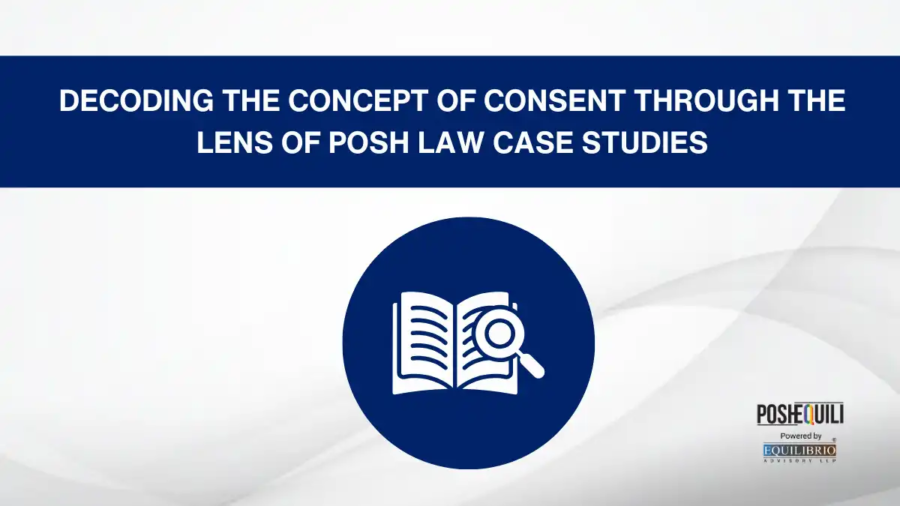Decoding The Concept Of Consent Through The Lens Of Posh Law Case Studies
The concept of consent, which has its roots in the ancient legal systems, was often a secondary consideration, as the concept of consent was being viewed through the patriarchal lens, where a woman’s access to autonomy and self-determination was heavily curtailed. However, with the rise of human rights and social justice movements, the concept of consent is not just being recognized as a fundamental right, but also as a psychological and social factor. For instance, the curation of the acronym FRIES which stand for Freely given, Reversible, Informed, Enthusiastic and Specific consent, indicates that consent must be given without any fear of consequence, can be withdrawn at any time, must be based on accurate information, must be given with willingness and must be specific to the activity, as it influences an individual’s ability to create a culture of respect and informed decision making.
And since understanding the meaning of consent is crucial in fostering respectful interactions and upholding ethical standards, it is paramount to decode the legal exploration of this concept as well. Thus, through this article, we will delve deeper into the definition of consent under the Indian contract law and the penal law, to better understand the concept of consent under the Sexual Harassment of Women at Workplace (Prevention, Prohibition & Redressal) Act, 2013 (POSH Law) context.
Understanding Consent through the Eyes of Law
The Sexual Harassment of Women at Workplace (Prevention, Prohibition and Redressal) Act, 2013 also known as the POSH Law, does not explicitly define “consent”. However, since Section 2(n) of the POSH Law is curated to essentially protect the complainant / aggrieved person who have been the targets of undesirable / inappropriate acts or behaviours of sexual nature, it implies that consent is a crucial factor in determining whether an act constitutes sexual harassment or not.
And since the POSH law does not specifically define consent, the following judicial pronouncements may be taken as the basis for expanding the interpretation of consent and thereby understanding the scope and applicability of consent under the POSH Law:
a. In Vishaka vs. State of Rajasthan, the Supreme Court observed that, “It is discriminatory against the complainant when she has reasonable grounds to believe that her objection to the conduct of the respondent would disadvantage her in connection with her employment or work including recruiting or promotion or when it creates a hostile work environment. Thus, adverse consequences might be visited if the complainant does not consent to the conduct in question or raises any objection thereto”.
b. The Madhya Pradesh High Court in Rajkishore Shrivastava vs. State of MP & Anr. Observed that, “consent given in consequence of misconception or fear cannot be considered to be free consent”.
c. The Mumbai Sessions Court observed that, “consent must result from exercise of intelligence and comprehension of the acts significance in order for it to be regarded as lawful. Thus, consent given by mentally challenged woman is not a valid consent”.
d. On 31st January 2025 the Delhi High Court has observed that, “the consent given by a woman for engaging in sexual relations with a man does not extend to capturing her private moments and posting inappropriate videos on social media”.
Apart from the above-stated judicial pronouncements explaining the concept of consent under the POSH Law, there are certain legislations which have explicitly defined consent. For instance, Section 13 of the Indian Contract Act defines consent as, “two or more persons are said to consent when they agree upon the same thing in the same sense”. Further Section 14 of the Act states that “Consent is said to be free when it is not caused by coercion, undue influence, fraud, misrepresentation, or mistake”. Thus, a summary of both these statutory provisions indicates that consent to be valid must be free, informed and voluntary.
The Supreme Court ruled in the State of Himachal Pradesh vs. Mango Ram that it is impossible to interpret the submission of the body out of fear of being terrorized as a sexual act with permission. The court observed that, “consent for the purpose of Section 375 IPC requires voluntary participation not only after the exercise of intelligence based on the knowledge of the significance and moral quality of the act but after having fully exercised the choice between the resistance and assent”.
Furthermore, Section 28 of the new official criminal code in India namely, the Bharatiya Nyaya Sanhita (BNS), titled “Consent Known to be Given Under Fear or Misconception,” addresses situations where a person’s consent is obtained through fear or a misunderstanding of facts. This section establishes that “consent is not legally valid if it is given under duress (fear) or due to a misconception, and any actions taken based on such consent may not be protected under the law”.
A summary of the above interpretations on the concept of consent indicate that the legislative and judicial organs have while expounding the definition of consent considered several factors such as power and hierarchy, consequence of fear in giving free consent, applicability of consent given in by an individual with an intellectual infirmity and the scope of over-evaluating or misusing consent which aligns with the definition of sexual harassment under the POSH Law.
To better understand and analyse on how the concept of consent under the POSH Law varies under different situations and relationships, the following are certain complaints-case studies that our firm received:
Case Study 1: “Exchange of Power: Quid Pro Quo & Consent”
The Complainant an intern of an organization had filed a complaint of sexual harassment against the Respondent who was her reporting manager. As the Respondent and the Complainant were staying in the same area, they would often travel together in the Respondents two-wheeler. One day while on their way back home, the Respondent who often complimented the Complainant for her looks and dressing sense, had forcefully attempted to kiss her without her consent, with a promise of converting her position as a full-time employee in the organisation.
Inference: This is a case of quid pro quo type of sexual harassment at workplace where the Respondent taking advantage of his position or authority, makes a demand of sexual favor from the Complainant against her consent in return for an employment benefit.
Case Study 2: “Setting Boundaries: Hostile Work Environment & Consent”
The Complainant filed a complaint of sexual harassment against the Respondent who was her colleague. Both the Complainant and Respondent were seated next to each other as they were allocated to work on a common project. The Complainant alleged that despite setting a professional boundary with the Respondent, he would often try to approach her on teams to have personal conversations and on a couple of occasions had followed her after office hours when she would go out to visit her friends who were working on other floors of the office building.
Inference: This is a case of unwelcome online and non-verbal conduct of sexual harassment at workplace where the Respondent sends unwelcome messages and constantly follows the Complainant without her consent, thereby creating a hostile work environment for the Complainant.
Case Study 3: “Consent in Live-in Relationships”
The Complainant filed a case of sexual harassment against the Respondent who was her colleague. Both the Complainant and the Respondent, who work in the same company team fell in love with each other and after a couple of months of dating they decided to live-in. The Complainant alleged that after a few months of live-in, the Respondent started acting very aggressive and one day when she resisted and expressed her discomfort in engaging in a sexual act with him, the Respondent started forcing himself on her and had physically abused her.
Inference: This is a classic example of sexual harassment between co-workers who also share a romantic relationship thereby indicating that consent is reversible. However, because both the Complainant and the Respondent are in a consensual relationship the said case would fall within the ambit of domestic violence law.
Case Study 4: “Consent in the Digital Era”
The Complainant filed a complaint of sexual harassment against the Respondent who is a co-worker working from different branch office of the company. The Complainant and the Respondent had met at an offsite event organized by the company and had exchanged their Instagram profile id. The Complainant alleged that initially she and the Respondent were having casual friendly conversations on the said social media platform but soon the message converted into the Respondent sending her videos and images consisting of sexual content which was perceived by the Complainant to be intrusive in nature.
Inference: This is a case of online sexual harassment where the Respondent misused the consent of the Complainant who exchanged her social media handle and was thereby sending her unwanted and unwelcome videos and images and creating an intimidating or hostile work environment for the Complainant.
In light of the above judicial pronouncements and case studies dealt with by the legal associates of our firm Equilibrio Advisory LLP, it may be summarized that consent under the POSH Law shall mean not just the absence of resistance but also about the presence of voluntary, informed, explicit and an agreement free from coercion or undue influence.
– Written by Adv. Vasantha Reviewed by Adv. Deeksha




